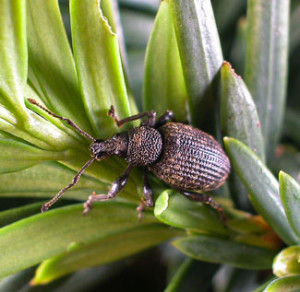The Plant Weevil – Another Fall-Invading Pest
By Chris Williams on October 30, 2014.

Black vine weevil
At this time of year, we’re often talking about fall-invading insects such as stink bugs, lady beetles, and western conifer seed bugs. There are a number of insects like these that are normally found outside feeding on plants, but that move into homes in the fall with the idea of spending the winter in comfort (see Plant Pests Are Getting Ready to Move Into Your Home!)
There’s one fall invader that we don’t see as often, but that in the right situation, can be an annoying pest – plant weevils. Weevils are a type of beetle. You probably know them as food pests in the kitchen. These weevils that enter homes in the fall are related but they feed on outdoor plants such as azalea, holly, privet, rhododendron, and yew, or on trees such as oaks, sycamore, and dogwood. Plant weevils that move indoors and infest homes include the strawberry root weevil, black vine weevil, yellow poplar weevil, Asiatic oak weevil, Japanese weevil, and two-banded Japanese weevil.
In most yards, plant weevils are a minor problem and may never be noticed either inside or out. But, homes that have lots of azaleas, rhododendrons, or other host plants around the foundation may find weevils crawling up outside walls (they don’t fly) and entering around doors, windows, or along the roof line. Once inside, the weevils hide in cracks and crevices, behind baseboards or drapes, in attics, or are sometimes found in sinks, tubs, or other places with water. They don’t bite or do any damage indoors.
Do I Have Plant Weevils Outside?
Weevils have a hard body with a unique shape. The head ends in an elongated snout with chewing mouthparts at the tip. They’re about ¼ to 1/2 inch long and usually brownish-black.
Adult weevils are hard to find since they feed on leaves mostly at night and drop to the ground when their host plant is disturbed. You can tell if your plants are infested with weevils by looking at individual leaves. These weevils eat semi-circular notches out of the outer edge of the leaf. Weevil larvae feed underground on the roots of the plants, sometimes damaging them severely.
What Can You Do About Invading Weevils?
Like most fall invaders, these weevils are difficult to control indoors with insecticides because they hide in lots of different places. A vacuum may be the better choice. Destroying undesirable host plants such as wild strawberries or brambles is a good option, but people usually want to keep their expensive foundation plantings. The host plants can be treated with insecticide in the summer. As always, weather-proofing doors and windows, screening vents, and caulking openings will help keep plant weevils and other fall invaders out.
At Colonial, we offer a Preventative Maintenance Program which can keep plant weevils and other fall-invading insects out of your home. We apply a preventative barrier treatment around the outside of your home, twice a year to offer all-year protection. See Our Preventative Maintenance Program Keeps Pests Away Year Round. Our motto is “Hear no weevil, see no weevil!”
Sign up for our biweekly email newsletter for more information about bugs and pests!